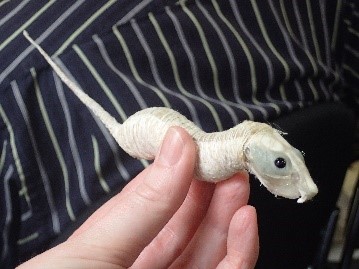Why NatSCA?
Joining NatSCA, for me, means being part of a group that makes me feel at home. By that I mean, being with others who view nature (living or dead) from a different perspective, and will look at something with a keen interest regardless of its condition – decomposing, or completely expired (like the barn resident below).

Skeleton from a barn (2016). Image: Sarah Scarlet-Farr
Membership of NatSCA also means being part of a support network, closing gaps we feel are limiting in terms of knowledge and skills. No one person can be an expert in everything, and sharing our experience with fellow colleagues helps us to look after and protect the collections we manage for future generations.
Why the NatSCA 2016 Conference?
This year’s conference was my first. The subject ‘How museums inspire our connection to the natural world’ was one everyone could relate to at any age or stage in life. It presented the opportunity to connect with like-minded colleagues sharing their experiences in live presentations, poster contributions, and from trade stands.

Taxidermy insides: rat form by Jazmine Miles-Long. Image: Sarah Scarlet-Farr

Taxidermy in progress: half-finished pigeon by Jazmine Miles-Long. Image: Sarah Scarlet-Farr
Selected Conference Highlights (for me):
Jennifer Gallichan and Annette Townsend’s ‘Museum in a House: Collections out of context’ contributed an inspirational presentation demonstrating the benefits of enabling practitioners to offer fun, creative and uniquely energising engagements with the public by utilising community support and unique venues.
Tom Hartman’s presentation on ‘Engaging with objects and images: using zoology specimens for outreach and education’ emphasised that having the freedom and opportunity to use collections without restriction, or organisational expectation, can support the development of ideas that better inspire and engage its users.
Sarah Wade’s presentation, ‘The Art of Craftivism in Museums’ demonstrated that problems such as pollution, poaching and extinction can be presented in an approachable and inspired way in tandem with showcasing beautiful ethical artwork (who would believe a Sainsbury’s plastic bag could be so stunning?).
Jazmine Miles-Long’s presentation, ‘How taxidermy can inspire us to view collections in a different light’ reminds us all that, whatever material we have in our collection, we should be fearless in our use of it and derive inspiration by connecting with it in many different ways. I was certainly engaged by the materials demonstrated for taxidermy mounts.
Chris Orgil, Adam S. Smith and Sheila Wrights’s poster, ‘Engaging the Public with Taxidermy Restoration at Wollaton Hall’ provided an illustrative snapshot of how sharing the processes involved in the restoration and colour correction of specimens can provide new forms of public engagements, and so inspire exhibitions and inventive collections’ learning spaces.
Creativity
A creative approach can help present controversial or sensitive topics with impact, yet greater subtlety. It can be used to deconstruct perceptions and create interpretive dialogues about nature between communities, and strengthen peoples’ connections with nature – in ways that suit them and meet their needs. Making room for a connection sometimes means moving out of a comfort zone, but If we retain curiosity we open our minds and so can inspire others.
Free-styling
What I appreciated most was that to inspire connections to nature means we must not control the experience of our visitors. Connecting to nature is not simply about transferring facts and figures.
We should aim to be less prescriptive about the limits of our offers to audiences to enable more artistic, inventive and playful engagements to take place.
As custodians of collections, we need to respond to our public. This means being open to alternative ideas, new ways of thinking, and exploring engagements utilising all our senses.
I am very grateful to NatSCA for supporting my attendance at this year’s conference.

